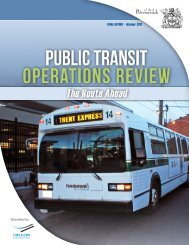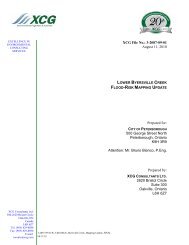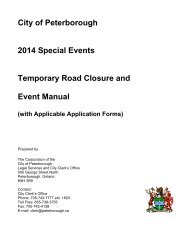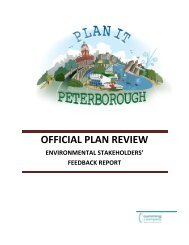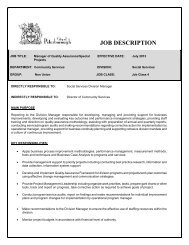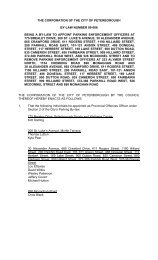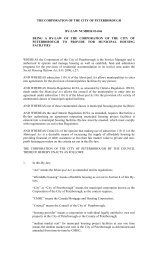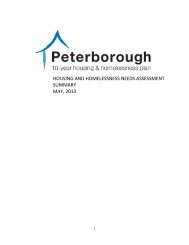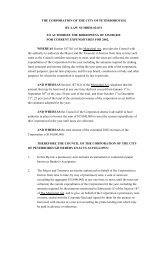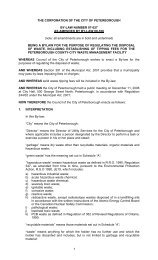Thompson Creek Flood Study Report - City of Peterborough
Thompson Creek Flood Study Report - City of Peterborough
Thompson Creek Flood Study Report - City of Peterborough
You also want an ePaper? Increase the reach of your titles
YUMPU automatically turns print PDFs into web optimized ePapers that Google loves.
<strong>Thompson</strong> <strong>Creek</strong> Detailed <strong>Flood</strong> Reduction <strong>Study</strong><br />
<strong>City</strong> <strong>of</strong> <strong>Peterborough</strong><br />
4.5 SIMULATION OF FLOOD VULNERABILITY DESIGN EVENTS<br />
Based upon the city-wide “<strong>Flood</strong> Reduction Master Plan,” the overall Terms <strong>of</strong><br />
Reference for the “Detailed <strong>Flood</strong> Reduction Studies” were developed. These defined<br />
an overall set <strong>of</strong> storm events which were to be used during the detailed studies to<br />
evaluate flood vulnerability. These “design rainfalls” were selected to: simulate<br />
conditions as they occurred during the July 2004 storm, address mapping <strong>of</strong> flood<br />
plains and overland flow routes and provide a basis for flood damage estimation. Each<br />
rainfall was simulated with the three models described above to calculate flows, water<br />
levels and extent <strong>of</strong> flooding. The following sections describe this process.<br />
4.5.1 Definition <strong>of</strong> Design Rainfalls<br />
As noted, the “design rainfalls” fall into three groups:<br />
<br />
<br />
<br />
the actual storm <strong>of</strong> July 14 -15, 2004 which led to such extensive flooding<br />
a set <strong>of</strong> storms with pre-defined total rainfall volumes (40mm, 60mm, 80mm,<br />
100mm, 120mm and 193mm) to be used for mapping the extent <strong>of</strong> flood plains<br />
and overland flow spills routes<br />
a set <strong>of</strong> storms with specific return periods (1 in 2 year, 1 in 5 year, 1 in 10 year,<br />
1 in 25 year, 1in 50 year and 1 in 100 year) to be used to evaluate the numerical<br />
value <strong>of</strong> average annual flood damages. This is required as part <strong>of</strong> the benefitcost<br />
evaluation <strong>of</strong> any proposed remedial measures.<br />
The following sections describe in detail the storms used based upon discussions held<br />
between <strong>City</strong> staff, MMM and consultants for the parallel detailed flood reduction<br />
studies underway on other <strong>City</strong> watersheds (see Appendix K for documentation).<br />
4.5.1.1 <strong>Peterborough</strong> Storm <strong>of</strong> July 14 - 15, 2004<br />
Given the significance <strong>of</strong> the July 2004 storm, a detailed investigation <strong>of</strong> its<br />
characteristics was commissioned by ORCA. This report was summarized in Section<br />
3.2.1 and the general characteristics <strong>of</strong> the storm were described. Based upon that<br />
initial analysis, a detailed temporal-spatial analysis <strong>of</strong> the storm was completed by<br />
UMA-AECON (2006) (see Appendix K for summary report). This analysis was<br />
completed to permit the best estimate <strong>of</strong> the storm’s rainfall volume – time distribution<br />
(hyetograph) over any particular watershed within the <strong>City</strong> to be computed.<br />
Information from that report was initially used to define a hyetograph for the <strong>Thompson</strong><br />
<strong>Creek</strong> study area. Figure 4.5.1 shows the study area boundary overlaid upon a map <strong>of</strong><br />
the total rainfall distribution from the radar analysis across the study area.<br />
14-06605-01-W01 <strong>City</strong> <strong>of</strong> <strong>Peterborough</strong> 54




